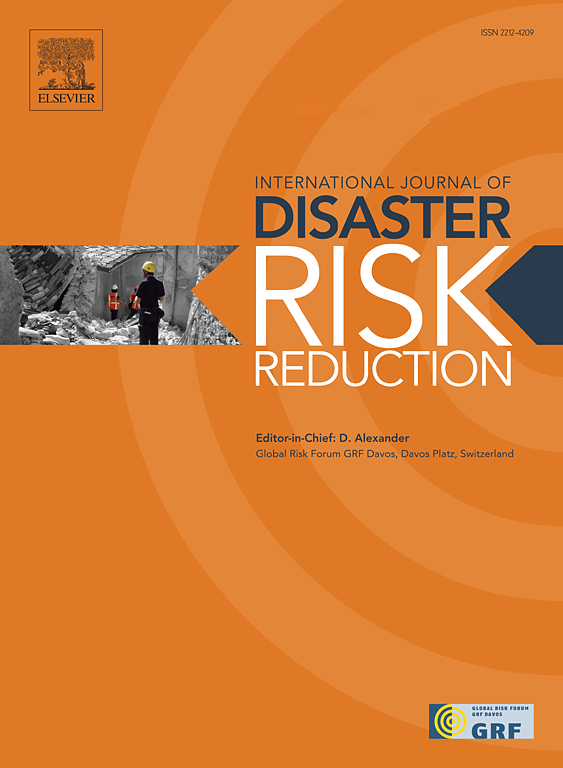降雨冲击使人们远离贫困线,使他们更穷:来自厄瓜多尔城市的证据
IF 4.2
1区 地球科学
Q1 GEOSCIENCES, MULTIDISCIPLINARY
International journal of disaster risk reduction
Pub Date : 2025-04-30
DOI:10.1016/j.ijdrr.2025.105539
引用次数: 0
摘要
这项研究旨在加深对极端天气与城市弱势群体之间相互作用的理解。我们使用2007年至2019年的年度家庭调查面板,天气信息和厄瓜多尔领土的地理特征来研究降雨冲击如何影响家庭贫困水平。通过应用固定效应模型,我们发现降雨冲击(包括降雨过剩和降雨不足)显著恶化了社会经济状况,使城市贫困家庭进一步陷入贫困。这些事件对妇女的影响尤为严重,因为妇女在非正规劳动力市场中所占比例过高,对生活在环境危害与经济脆弱性并存的高度易感地区的家庭的影响也尤为严重。处于最低百分位的家庭受到的影响最大,这突显出他们的复原力和适应能力有限。本研究通过将天气数据、地理特征和社会经济脆弱性纳入分析,深入了解降雨冲击对中低收入国家弱势城市人口的影响。它提供了一个更全面的了解天气冲击如何与脆弱性的多个维度相交,特别是对高度易感地区的妇女和家庭来说,同时也经历着贫困。此外,报告强调需要有针对性的干预措施和复原力建设战略,以减轻这些不利影响,特别是对弱势群体的不利影响。本文章由计算机程序翻译,如有差异,请以英文原文为准。
Rainfall shocks push people away from the poverty line, making them poorer: Evidence from urban Ecuador
This study seeks to deepen the understanding of the interactions between weather extremes and vulnerable groups in urban areas. We use annual panels of household surveys from 2007 to 2019, weather information, and geographical characteristics of the territories in Ecuador to examine how rainfall shocks affect households’ poverty levels. By applying fixed effects models, we find that rainfall shocks, including excess and lack of rain, significantly worsen socioeconomic conditions, pushing poor urban households further down into poverty. These events disproportionately affect women, who are overrepresented in the informal labor market, and households living in highly susceptible areas, where exposure to environmental hazards intersects with economic vulnerability. Families in the lowest percentiles are most affected, underscoring their limited resilience and adaptive capacity. This study provides insights into the effects of rainfall shocks on disadvantaged urban populations in low and middle-income countries by integrating weather data, geographical characteristics, and socioeconomic vulnerabilities into the analysis. It offers a more comprehensive understanding of how weather shocks intersect with multiple dimensions of vulnerability, particularly for women and households in highly susceptible areas who are also experiencing poverty. Furthermore, it emphasizes the need for targeted interventions and resilience-building strategies to mitigate these adverse effects, especially for vulnerable populations.
求助全文
通过发布文献求助,成功后即可免费获取论文全文。
去求助
来源期刊

International journal of disaster risk reduction
GEOSCIENCES, MULTIDISCIPLINARYMETEOROLOGY-METEOROLOGY & ATMOSPHERIC SCIENCES
CiteScore
8.70
自引率
18.00%
发文量
688
审稿时长
79 days
期刊介绍:
The International Journal of Disaster Risk Reduction (IJDRR) is the journal for researchers, policymakers and practitioners across diverse disciplines: earth sciences and their implications; environmental sciences; engineering; urban studies; geography; and the social sciences. IJDRR publishes fundamental and applied research, critical reviews, policy papers and case studies with a particular focus on multi-disciplinary research that aims to reduce the impact of natural, technological, social and intentional disasters. IJDRR stimulates exchange of ideas and knowledge transfer on disaster research, mitigation, adaptation, prevention and risk reduction at all geographical scales: local, national and international.
Key topics:-
-multifaceted disaster and cascading disasters
-the development of disaster risk reduction strategies and techniques
-discussion and development of effective warning and educational systems for risk management at all levels
-disasters associated with climate change
-vulnerability analysis and vulnerability trends
-emerging risks
-resilience against disasters.
The journal particularly encourages papers that approach risk from a multi-disciplinary perspective.
 求助内容:
求助内容: 应助结果提醒方式:
应助结果提醒方式:


